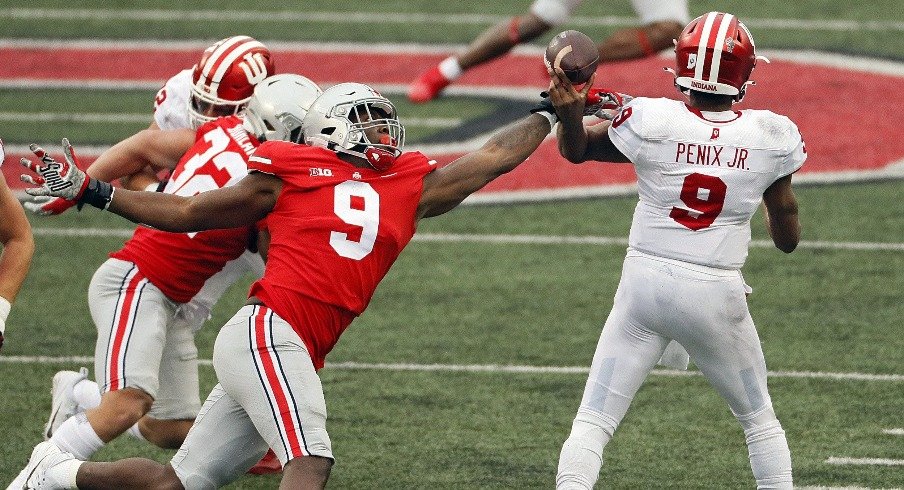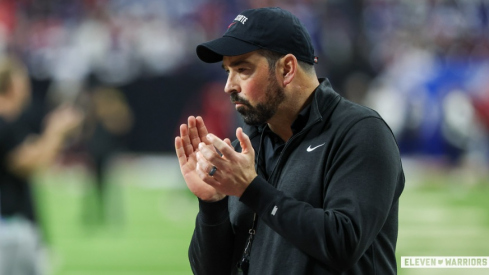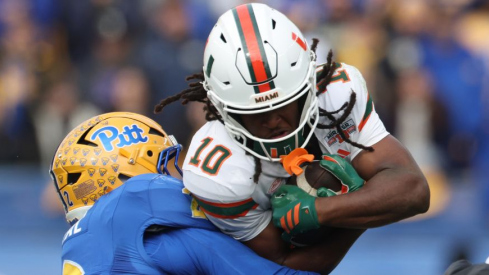We've all tried to forget last season's defense and rightfully so after it ranked No. 43 in scoring defense (25.8 ppg), No. 59 in total defense (400.9 ypg) and No. 122 out of 127 teams in pass defense, giving up 304 yards per contest.
Five of eight opponents racked up at least 370 total yards highlighted by 444 from Clemson, 490 by Indiana and [checks notes] SIX HUNDRED TWENTY-ONE by Alabama.
Those same three teams all shredded Ohio State's secondary for at least 400 yards, led by 491 from Indiana's Michael Penix Jr. Both Penix Jr. and the Crimson Tide's Mac Jones lit up the Buckeyes for five passing touchdowns.
A couple key reasons for Ohio State's inability to stop opponents from scoring were an overall issue with getting offenses off schedule and creating very little disruption.
The 2020 Buckeyes ranked just 76th nationally in tackles for loss per game with 46 across eight contests. That 5.75 per game average ranks as the second-worst by an Ohio State defense dating back to Urban Meyer's arrival in 2012. Meyer's first group generated just 5.33 tackles for loss per game. In between the 2012 and 2020 squads, Ohio State averaged anywhere between 6.39 and 8.86 per game.
The 2014 national championship defense, which certainly had its own statistical gaps if we're being honest, posted 7.33 tackles for loss per outing, good for No. 14 nationally. The 2019 defense, which ranked in the top-4 in both scoring defense and total defense, boasted 8.86 TFL per game, good for No. 2 in the land.
Getting back to the 2020 outfit, of note is 23 of the 46 total tackles for loss came from players no longer on the roster. Justin Hilliard led the way with 5.0, Tommy Togiai was next with 4.5, Tuf Borland and Jonathon Cooper tallied 3.5, Baron Browning posted 3.0, Pete Werner notched 2.5 and Shaun Wade added 1.0. In fact, only two returning defenders - Zach Harrison (4.5) and Haskell Garrett (4.0) - posted more than two tackles for loss a season ago.
Depending on your outlook, losing 50% of said production across seven different players could be a good or bad thing. On one hand, it signals a new crop of players are set to play bigger roles. On the other, it means a lot of the most statistically disruptive players are gone.
An interesting twist on last season's otherwise defensive struggles came as the unit ranked No. 6 in the country forcing 2.4 turnovers per game. That mark was easily the best dating back to Meyer's arrival. Only the 2016 Ohio State defense generated more than two turnovers per game (2.1) during that span.
In a similar theme to tackles for loss, of last year's 19 takeaways, eight came via the departed Hilliard, Browning and Wade. Hell, Hilliard had half of those takeaways himself despite logging only the 13th-most snaps among OSU defenders.
Of the returning players, Sevyn Banks posted an interception and a fumble recovery, with Josh Proctor and Marcus Hooker also producing one of each.
While takeaways turned out to be a rare bright spot, another key metric, opponent third down conversion rate, was troublesome.
Ohio State opponents converted 37.1% of the time (39-of-105), good for a modest 35th nationally. From Meyer's arrival in 2012 through 2019, no OSU defense surrendered more than 35.6% of third down tries (2013, 30th).
The 2020 metric is even worse when you look at the second half. The Buckeyes allowed third down conversions on a whopping 52.2% of tries in the third quarter and 45.5% in the fourth for a combined second half conversion rate allowed of 48.2% (27-of-56). Yikes.
Putting teams in third-and-medium to third-and-long is certainly helpful in getting stops and with the lack of disruptive plays, it's unsurprising the team allowed such a high conversion rate.
This season, the returning known disruptors are clearly Garrett and Harrison. Garrett was sensational a season ago, logging the noted 4.0 tackles for loss, 20 stops, a pick six, a quarterback hurry and a pass breakup. His season was even more impressive as he quickly returned from a gunshot wound to his cheek in late August.
Harrison's 4.5 tackles for loss seemed a bit quiet against expectations but he did miss a game on the way to 14 stops, two pass breakups and a fumble recovery. For Ohio State's defense to realize significant improvement however, he'll need to post per-game production averages much higher across the board.
How effective fellow ends Tyreke Smith, Jack Sawyer and Tyler Friday, to name a few, can contribute to the pass rush will also go a long way in taking some pressure off a much-maligned secondary looking to rebound in its own right. Smith was shockingly unproductive last season, logging the second-most snaps at defensive end with just one tackle for loss and eight total stops to show for it. He has to be hungry to dial up some pressure this fall and there's no reason to think the talent isn't there to be more of a difference maker. And who knows, maybe J.T. Tuimoloau commits to Ohio State and is an immediate factor.
Replacing last season's top four linebackers is also an opportunity for veterans like Teradja Mitchell and Dallas Gant to show they can be disruptors on an improved defense. Mitchell is certainly ready to hit somebody and Gant came in highly regarded but both saw less than 100 snaps last year and both finished with 0.5 tackles for loss. For his part, Gant did log 17 tackles to Mitchell's eight and posted a pass breakup, forced fumble and fumble recovery in limited duty. Both saw time on kickoff coverage while Gant was also a gunner on the punt team.
With the bullet now in effect, Ronnie Hickman, Craig Young and maybe even Kourt Williams will have chances to create havoc for opposing offenses but projecting with confidence is tough considering neither Hickman nor Young logged more than 46 snaps last year and Williams missed the season due to injury.
Finally, in the secondary, Wade left for the NFL leaving Banks to serve as the team's No. 1 corner following a seven pass breakup season with Cameron Brown most likely holding down the other outside cornerback spot. Brown is of course returning from a season-ending torn Achilles meaning the door is open for guys like Ryan Watts and Lejond Cavazos looking to make a move. Jordan Hancock could even make a bid before the season ends despite not being on campus to take part in spring camp.
In the slot, Lathan Ransom appeared to surpass Marcus Williamson in spring and if I had to bet, he'll be one of the team's top playmakers after playing just 61 snaps last season.
Finally, at safety, I'm still all-in on Josh Proctor. The hard-hitter is working on being more disciplined particularly in run support but he did record a couple turnovers last year while dropping what felt like at least three ready-made interceptions. If he takes the next step in his development, Ohio State's defense will provide a much more dangerous test.
It's impossible for the defense to not improve. Simply having a full spring camp, additional time for Coombs to get things settled and the law of averages say things will get much better. That said, as a pessimist by nature, I'm admittedly still not sold that dramatic improvement should be expected.
Can this group come together and be the top-20 defense Buckeye fans are used to? It's absolutely plausible but to think it's a lock feels a bit homer-ish.


